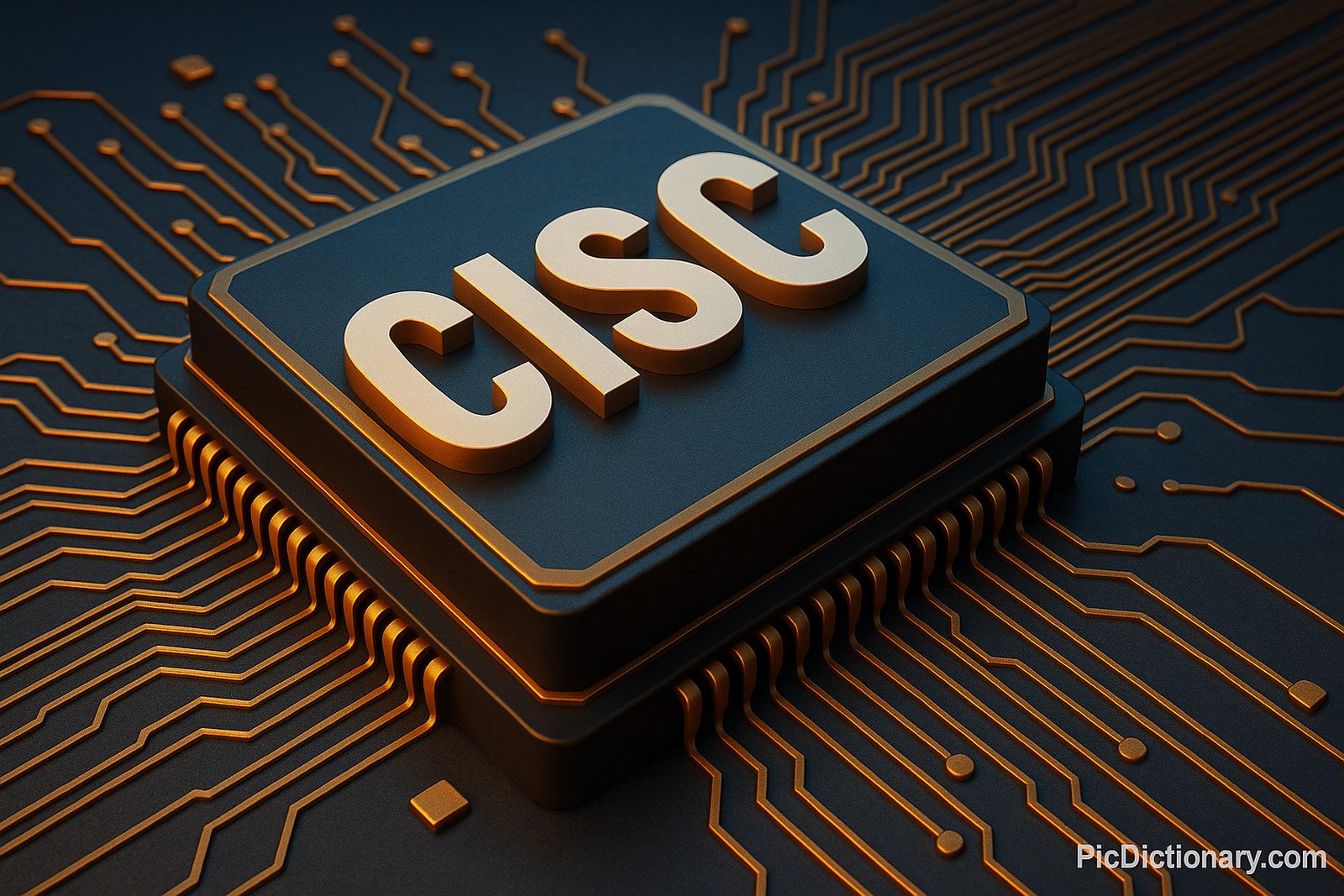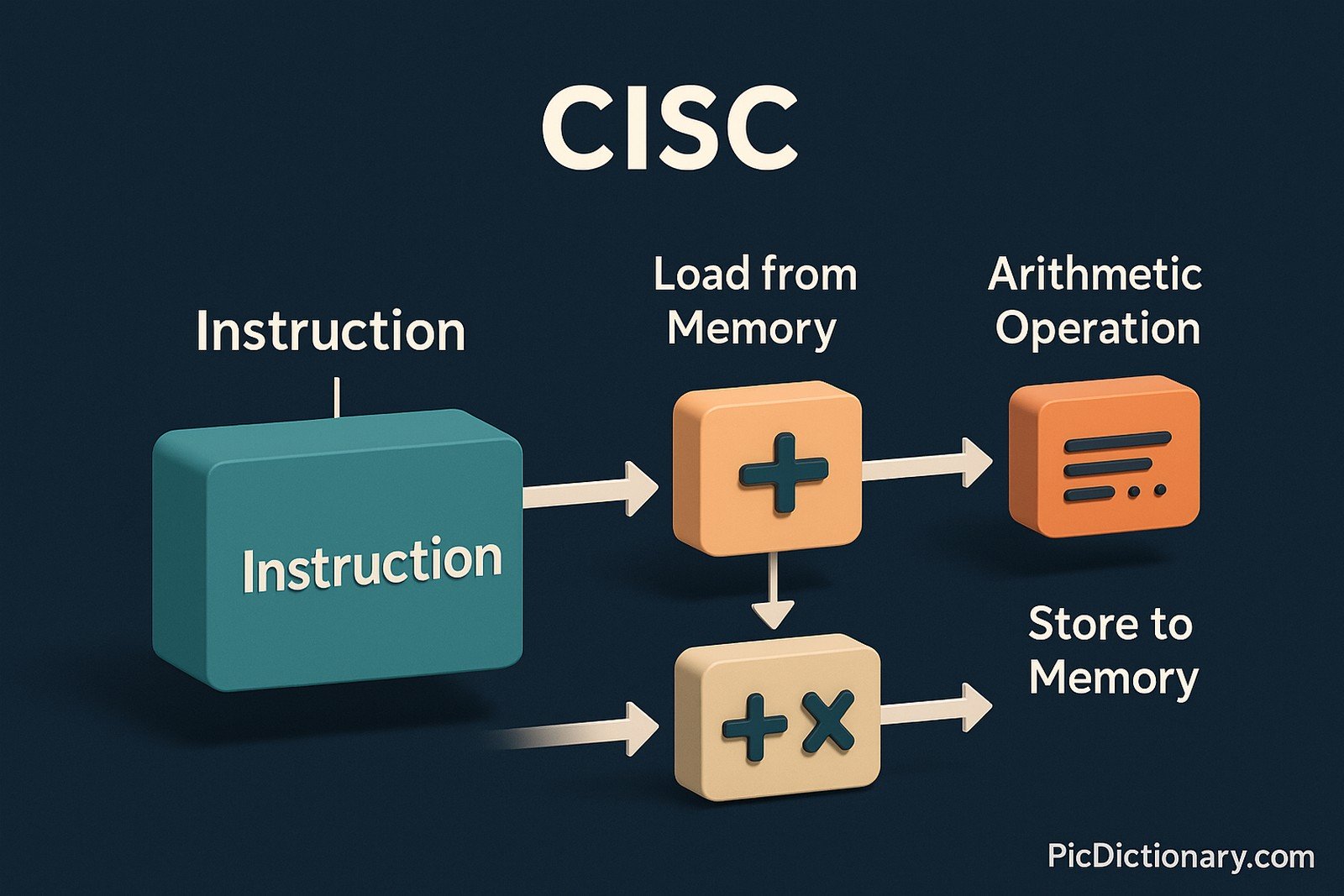CISC (Complex Instruction Set Computer)

Quick Navigation:
- CISC Definition
- CISC Explained Easy
- CISC Origin
- CISC Etymology
- CISC Usage Trends
- CISC Usage
- CISC Examples in Context
- CISC FAQ
- CISC Related Words
CISC Definition
CISC (Complex Instruction Set Computer) is a type of computer architecture where a single instruction can execute several low-level operations, such as a load from memory, an arithmetic operation, and a memory store, all at once. CISC architectures are designed to minimize the number of instructions per program by incorporating more complex instructions that can handle multi-step operations. This design reduces memory usage and simplifies compiler design but can sometimes make the CPU design more complicated and slower compared to RISC architectures. Examples of CISC architectures include x86 and VAX.
CISC Explained Easy
Imagine if you could tell someone to "bake a cake" and they would do all the steps: mix ingredients, preheat the oven, bake, and decorate — all from one instruction! That’s what CISC is for computers. Instead of giving the computer lots of small steps, you give it big instructions that do a lot of things in one go.
CISC Origin
The concept of CISC was developed in the 1960s and 1970s when memory was expensive and limited. Designers focused on making each instruction as powerful and efficient as possible, reducing the need for multiple instructions and saving memory space.
CISC Etymology
The term CISC was created to differentiate from RISC (Reduced Instruction Set Computer). It emphasizes the complexity and breadth of operations that a single instruction can perform.
CISC Usage Trends
CISC architectures, particularly the x86 family, continue to dominate personal computers and servers. Although modern processors blend both CISC and RISC principles, the trend has been to simplify execution stages internally, even when instructions appear complex on the surface. This hybrid approach allows CISC CPUs to compete in performance with RISC designs.
CISC Usage
- Formal/Technical Tagging:
- Computer Architecture
- CPU Design
- Instruction Set Architecture - Typical Collocations:
- "CISC processor"
- "complex instruction set"
- "CISC architecture design"
- "x86 CISC-based CPU"
CISC Examples in Context
- The Intel Core i9 processor is based on a CISC architecture.
- Early computer systems like the VAX used CISC designs to maximize instruction power.
- Developers writing low-level assembly code for x86 architectures deal with CISC instructions.
CISC FAQ
- What is CISC?
CISC stands for Complex Instruction Set Computer, an architecture that uses instructions capable of performing multiple operations. - Why was CISC developed?
CISC was developed to make efficient use of limited memory by reducing the number of instructions required. - How does CISC differ from RISC?
CISC instructions are more complex and perform multiple operations, while RISC instructions are simple and execute in single steps. - What are examples of CISC processors?
Intel's x86 and DEC’s VAX are prime examples of CISC architectures. - Is CISC still used today?
Yes, most personal computers and servers use CISC-based processors, notably the x86 family. - Does CISC make CPUs slower?
Not necessarily. Although instructions are complex, modern CPUs use micro-operations to improve speed. - Can CISC processors run RISC instructions?
They can emulate RISC behavior internally by translating complex instructions into simpler micro-operations. - Why is x86 architecture considered CISC?
Because its instructions are complex and can perform multiple tasks within a single command. - What is the advantage of CISC?
It reduces program size and makes compilers simpler by having powerful instructions. - What’s the downside of CISC?
It can make CPU design more complex and sometimes less efficient per clock cycle.

CISC Related Words
- Categories/Topics:
- CPU Architecture
- Computer Hardware
- Microprocessors
- Instruction Set
Did you know?
The original IBM System/360, one of the most influential computer lines ever produced, was based on CISC architecture, enabling an entire range of computers to share the same instruction set and software compatibility.
PicDictionary.com is an online dictionary in pictures. If you have questions or suggestions, please reach out to us on WhatsApp or Twitter.Authors | Arjun Vishnu | @ArjunAndVishnu

I am Vishnu. I like AI, Linux, Single Board Computers, and Cloud Computing. I create the web & video content, and I also write for popular websites.
My younger brother, Arjun handles image & video editing. Together, we run a YouTube Channel that's focused on reviewing gadgets and explaining technology.



Comments powered by CComment